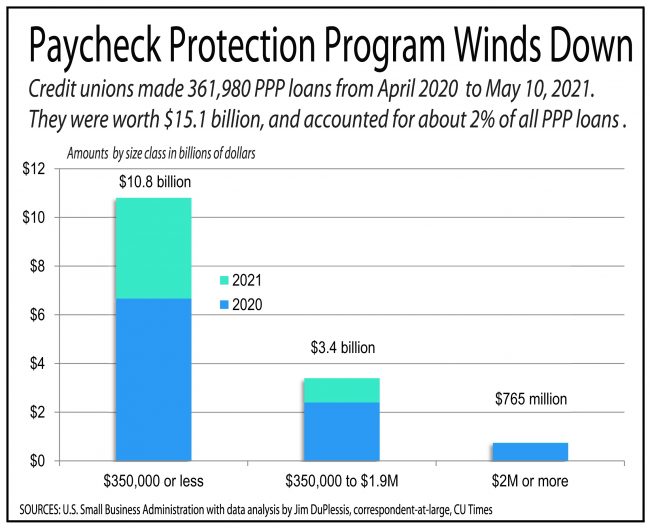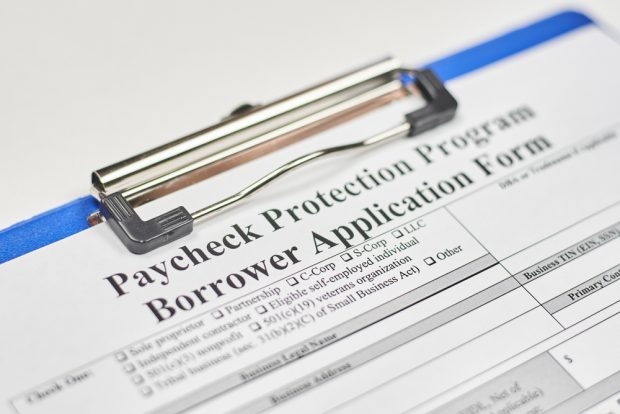The paycheck protection program is fading into history, but its effects on credit unions will continue from both the experiences gained and the impacts on their books that still play out.
The US Small Business Administration administered the program, which was designed to help small businesses survive closures and cutbacks caused by the COVID-19 pandemic. The loans were designed to be canceled if borrowers qualified to use the funds primarily to support the payroll.
The first iterations of the PPP took place from April to August 2020. It was relaunched in December and continued to receive requests until the end of May, if they came from community development financial institutions (CDFI).
A CU time Analysis of data on the level of SBA loans up to May 10 showed that only 965 of the country’s 5,175 credit unions participated, with many relatively small credit unions playing disproportionately large roles in the program. It also showed that credit unions generated $ 15.1 billion through 361,980 PPP loans to help support 199,598 jobs.
And participating credit unions are expected to collect more than $ 614 million in processing fees paid by the SBA as loans are canceled.
The mix of credit union sizes can be seen among the 15 with the largest P3 loan amounts for 2020 and 2021 through May 10. They included four with assets of less than $ 2 billion as of March 31:
- Greater Nevada Credit Union of Carson City, Nevada ($ 1.5 billion in assets, 79,463 members), which generated $ 737.7 million in P3 loans to support 73,474 jobs.
- Self-Help Federal Credit Union of Durham, North Carolina ($ 1.7 billion in assets, 97,314 members), which provided $ 243.6 million in PPP loans to support 26,172 jobs.
- Notre Dame Federal Credit Union of Notre Dame, Ind. ($ 887.7 million in assets, 59,820 members), which generated $ 234.7 million in PPP loans to support 25,295 jobs.
- Vibrant Credit Union of Moline, Ill. ($ 1 billion in assets, 50,571 members), which generated $ 200.8 million in PPP loans to support 21,662 jobs.
(See how the top 15 credit union PPP initiators compared to each other, and how all credit union PPP initiators performed by region, in this infographic in the June 16, 2021 print issue of CU time.)
The Greater Nevada Credit Union led in 2020 with $ 348 million in loans and ranks second in 2021 loans at $ 149.6 million, supporting 14,459 jobs. Leading this year is the Mountain America Federal Credit Union of Salt Lake City ($ 12.9 billion in assets, 977,090 members), which generated $ 158.7 million to support 20,265 jobs.
 Jeremy Gilpin
Jeremy GilpinJeremy Gilpin, executive vice president of Greater Commercial Lending, a CUSO in Greater Nevada, said he expected the final number for 2021 to be around 3,300 loans for nearly $ 160 million. Like most lenders, his average loan size was smaller this year.
Overall, the average P3 loan through a credit union was $ 47,385 last year and $ 34,036 this year. For all lenders, the average was $ 101,554 last year and $ 43,975 this year.
The 2020 credit union cycles supported about 1.3 million jobs, or about six jobs per loan. The second round supported 670,171 jobs, or about four jobs per loan.
“More underserved people were able to take advantage of this ride,” said Gilpin. “It was a great relief to the owner of the small business. “
Gilpin said the PPP loans have helped deepen relationships with existing commercial borrowers and attract new ones. “We have expanded our membership base.
One of the reasons for these lower averages was that the maximum loan for 2021 was $ 2 million, up from a maximum of $ 10 million last year.
Credit unions made four loans of up to $ 10 million for the 2020 cycle. One was from KeyPoint Credit Union in Santa Clara, Calif. ($ 1.6 billion in assets, 59,781 members) for supporting 500 jobs at Catalyst Family Inc., a Santa Clara County-based non-profit organization with more than 150 child care centers across California, serving more than 20,000 children.
The credit unions made six loans for less than $ 100. The smallest was $ 70 from America’s First Federal Credit Union in Riverdale, Utah ($ 15.7 billion in assets, 1.2 million members) to support employment for a beneficiary in Long Beach, California.

Credit unions accounted for just under 2% of the total $ 778.6 billion in PPP loans that the SBA approved from April 2020 to May 10, 2021. They also accounted for 2% of the $ 37.3 billion approved. , but not yet disbursed as of May 10.
The impact of PPP loans on credit unions has manifested itself on both the balance sheet and the income statement.
PPP loans represented just under 3% of total originations for the 12 months ending March 31.
They reprinted 2.8% of the $ 532.6 billion in total arrangements from April to December 2020, and the amount of PPP loans approved from January 1 to May 10 was 2.9% of the $ 181.4 billion in loans. total first trimester fixtures.
After the PPP started in April 2020, the NCUA asked credit unions to record these forgivable loans under the balance sheet line of their appeal report for “All other unsecured loans”.
As of March 31, 851 credit unions had 200,841 PPP loans on their balance sheets worth $ 8.5 billion. These credit unions represent more than half of the assets and members of credit unions in the country.
Including PPP loans, the unsecured loan category for these 851 credit unions was $ 31.1 billion as of March 31, up 31% from the previous year. Excluding PPP, their unsecured loans fell 4.8% to $ 22.6 billion.
For the 4,324 credit unions with no P3s on their books as of March 31, other unsecured loans fell 2.1% to $ 22 billion.
Combining the 5,175 credit unions, the category of unsecured loans, including P3s, increased 14.9% to $ 53.2 billion as of March 31. Excluding PPP, unsecured loans fell 3.5% to $ 44.6 billion.
Credit unions will also continue to collect processing fees as PPP loans are canceled, a process that lenders say could be completed soon for 2020 loans, but could take until this fall for the 2021 harvest.
The fees are typically 5% of the amount granted for loans up to $ 350,000, 3% for loans between $ 350,000 and $ 2 million, and 1% for loans of $ 2 million or more. Credit unions are expected to generate $ 389 million in fees on 2020 PPP loans and at least $ 227 million in fees on 2021 loans.
The amount for 2021 will likely be larger because the SBA has until the end of June to approve certain requests submitted until May 31 by the CDFIs.
In addition, the new program increased fees for loans under $ 50,000 in response to complaints that the 5% fee did not cover the costs of smaller loans. The changes allowed loans of less than $ 5,000 to receive a 50% fee and those of $ 5,000 to $ 50,000 to receive a fixed fee of $ 2,500.

